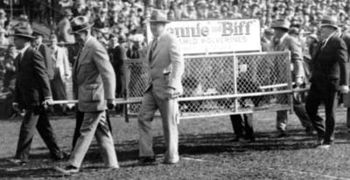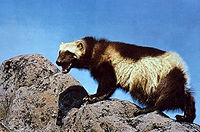
Biff, the Michigan Wolverine
Encyclopedia

Wolverine
The wolverine, pronounced , Gulo gulo , also referred to as glutton, carcajou, skunk bear, or quickhatch, is the largest land-dwelling species of the family Mustelidae . It is a stocky and muscular carnivore, more closely resembling a small bear than other mustelids...
who served as a team mascot at University of Michigan
University of Michigan
The University of Michigan is a public research university located in Ann Arbor, Michigan in the United States. It is the state's oldest university and the flagship campus of the University of Michigan...
Wolverines
Michigan Wolverines
The Michigan Wolverines comprise 27 varsity sports teams at the University of Michigan. These teams compete in the NCAA's Division I and in the Big Ten Conference in all sports except men's ice hockey which competes in the NCAA D1 Central Collegiate Hockey Association, and women's water polo, which...
football
Michigan Wolverines football
The Michigan Wolverines football program represents the University of Michigan in college football at the NCAA Division I Football Bowl Subdivision level. Michigan has the most all-time wins and the highest winning percentage in college football history...
games and was later kept in a small zoo at the University of Michigan in the 1920s and 1930s. In the mid-1920s, before the acquisition of a live wolverine, the University of Michigan used a mounted and stuffed wolverine, also named "Biff", as the team mascot.
In 1923, after seeing the University of Wisconsin football team carry live badgers at games, University of Michigan athletic director
Athletic director
An athletic director is an administrator at many American colleges and universities, as well as in larger high schools and middle schools, who oversees the work of coaches and related staff involved in intercollegiate or interscholastic athletic programs...
and football coach Fielding H. Yost decided to procure a wolverine. Despite writing letters to 68 trappers, Yost was reportedly unable to find a wolverine. The best he could do in 1924 was to obtain a mounted and stuffed wolverine from the Hudson's Bay Company
Hudson's Bay Company
The Hudson's Bay Company , abbreviated HBC, or "The Bay" is the oldest commercial corporation in North America and one of the oldest in the world. A fur trading business for much of its existence, today Hudson's Bay Company owns and operates retail stores throughout Canada...
. The stuffed wolverine was named “Biff” and was featured on the cover of a 1925 game program, along with team captain Robert J. Brown
Robert J. Brown
Robert J. Brown was an American football center and university regent. He played college football for the University of Michigan from 1923 to 1925. He later served as a member of the Board of Regents of the University of Michigan from 1967 to 1974...
straining to hold Biff on a leash. The caption to the photograph read: “Capt. Bob Brown and Biff: The Wolverine Mascot of Michigan Athletic Teams Is Noted for Its Ferocity and Gameness in Battle, a Characteristic of Every Team that Wears the Maize and Blue.”
Then, in 1927, the Detroit Zoo
Detroit Zoo
The Detroit Zoological Park, commonly known as the Detroit Zoo, is located about north of the Detroit city limits at the intersection of Woodward Avenue, 10 Mile Road, and Interstate 696 in Royal Oak and Huntington Woods, Michigan, USA...
acquired ten wolverines from Alaska. During the 1927 season, Yost struck a deal with the zoo to have two of the wolverines transported to Ann Arbor on football Saturdays. The two wolverines were nicknamed “Biff” and “Bennie” and were paraded around Michigan Stadium
Michigan Stadium
Michigan Stadium, nicknamed "The Big House," is the football stadium for the University of Michigan in Ann Arbor, Michigan. Michigan Stadium was built in 1927 at a cost of $950,000 and had an original capacity of 72,000. Before playing football at the stadium, the Wolverines played on Ferry Field...
during football games. Biff and Bennie’s first appearance came on dedication day for Michigan Stadium
Michigan Stadium
Michigan Stadium, nicknamed "The Big House," is the football stadium for the University of Michigan in Ann Arbor, Michigan. Michigan Stadium was built in 1927 at a cost of $950,000 and had an original capacity of 72,000. Before playing football at the stadium, the Wolverines played on Ferry Field...
in 1927.

Bentley Historical Library
The Bentley Historical Library is a historical library located on the University of Michigan's North Campus in Ann Arbor. It was established in 1935 by the regents of the University of Michigan...
states that the two live wolverine mascots were brought to the stadium for “a number of years.” The Bentley account also states that both Biff and Bennie lived for a time at a small zoo near the Natural History Museum, "but eventually became too vicious to remain on campus and were moved to the Detroit Zoo."
Blogger Brian Cook, owner of the popular blog MGoBlog, was given the middle name "Biff" by his parents as a tribute to this legend of Michigan sports.

